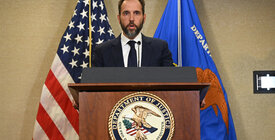Donald Trump’s infamous call to Georgia Secretary of State Brad Raffensperger is now a key piece of evidence in the criminal investigations into the former president’s attempts to overturn the 2020 election. During the January 2, 2021, call, Trump invoked several false claims of widespread voter fraud to pressure Raffensperger to reverse the state’s election results, ranging from lies about out-of-state and dead voters to conspiracy theories about drop box stuffing and compromised election equipment. These false claims drove the January 6 attack on the Capitol and continue to damage our democracy.
For years, the Brennan Center has debunked the voter fraud myths that undermine trust in American elections. The claims Trump made during his phone call with Raffensperger are no different: each has been proven false again and again. Below are several of the falsehoods followed by evidence disproving them.
Claims about voter impersonation and dead people voting in the 2020 Georgia election:
- “I think the number is close to 5,000 people. And they went to obituaries. They went to all sorts of methods to come up with an accurate number and a minimum is close to about 5,000 voters.”
- “But you also have a substantial numbers [sic] of people, thousands and thousands who went to the voting place on November 3, were told they couldn’t vote, were told they couldn’t vote because a ballot had been put on their name.”
The Trump campaign itself disproved these claims. A research report that it commissioned (but kept secret) identified only 23 “potential” episodes of people impersonating dead voters throughout the state. Georgia’s official investigation found four.
Since the early 2000s, the Brennan Center has debunked false allegations of dead voter fraud and voter impersonation by demonstrating that such misconduct is extraordinarily rare. Many safeguards prevent someone from voting under another person’s name. State and federal laws prohibit voter impersonation, including voting on behalf of a deceased voter. All states regularly update their voter rolls to remove deceased voters, and they base those removals on data obtained from state and federal agencies. And identification verification safeguards such as signature matching provide additional layers of protection against voter impersonation.
Claims about drop boxes:
- “And you had drop boxes, which is very bad. You had drop boxes that were picked up. We have photographs and we have affidavits from many people.”
- “You have drop boxes where the box was picked up but not delivered for three days. So all sorts of things could have happened to that box, including, you know, putting in the votes that you wanted.”
Drop boxes are a tested and common method of returning mail ballots. According to the 2016 Survey of the Performance of American Elections at Harvard University, 73 percent of voters in Colorado, 59 percent in Oregon, and 65 percent in Washington returned their ballots to a physical location such as a drop box. Numerous analyses have shown that voter fraud related to ballots sent by mail or placed in a drop box is so rare that it is more likely that someone will be struck by lightning than commit mail ballot fraud. And contrary to the unsubstantiated claim about “drop boxes that were picked up,” states have developed many layers of security for drop boxes, including locks or tamper-evident seals, secure fastenings to an immovable object if at an unstaffed location, placement behind a counter or otherwise safeguarded if at a staffed location, and video surveillance or monitoring by bipartisan teams of election workers.
Claims that people can’t vote without a permanent address:
- “You had 904 who only voted where they had just a . . . post office box number . . . and that’s not allowed.”
Days after the phone call, Georgia election official Gabriel Sterling reported that the secretary of state’s investigation had not uncovered any instances of people who registered to vote using only post office boxes.
Moreover, the implication that that people need a permanent residential address to register to vote is incorrect. Courts across the country have affirmed that people who do not have a permanent residential address are still eligible to vote out of recognition that such a requirement would disqualify large swaths of eligible voters without traditional addresses, such as people experiencing homelessness and tribal communities without postal service.
Claims that ballot counting by election workers Ruby Freeman and her daughter Wandrea “Shaye” Moss was “vote scamming”:
- “We had at least 18,000 . . . voters having to do with [Freeman]. She’s a vote scammer, a professional vote scammer and hustler.”
- “[The 18,000 ballots] weren’t in an official voter box, but they were in what looked to be suitcases or trunks, suitcases but they weren’t in voter boxes.”
Trump mischaracterized the legitimate election worker activity of Moss and Freeman as ballot tampering, falsely alleging that they pulled fake ballots from suitcases hidden under tables at a Georgia ballot-counting center. The House Select Committee to Investigate the January 6 Attack documented the flood of racist threats that both women received after Trump and his lawyer Rudy Giuliani publicly identified them.
After reviewing footage of the alleged incident, state and county officials determined that the women simply pulled ballot bins out from under the tables as part of the normal ballot counting process. The former U.S. attorney for the Northern District of Georgia testified before the January 6 committee that there was no evidence of fraud during this episode. And Giuliani himself has since conceded that his accusations against Moss and Freeman were false.
Recycled 2016 claims about out-of-state voters:
- “You had out-of-state voters. They voted in Georgia but they were from out of state.”
- “And then they came back in and they voted.”
The Brennan Center, public reporting, and a member of the Trump administration’s own voter fraud commission have all rebutted the various claims about out-of-state voting. With respect to Georgia in particular, a lawyer representing the secretary of state’s office clarified that “every one we’ve been through are people that lived in Georgia, moved to a different state but they moved back to Georgia legitimately.”
All states regularly update their voter rolls to remove voters who have moved out of state. The Election Registration Information Center, of which Georgia is a member, helps member states identify voters who have moved so they can update their rolls accordingly.
And in certain instances, people may vote while out of state. For example, it is legal to move out of state temporarily (e.g., as a college student or member of the military) and still vote in Georgia.
Claims that absentee ballots sent to vacant addresses were evidence of fraud:
- “You had absentee ballots . . . sent to vacant addresses. They had nothing on them about addresses, that’s 2,326.”
During the phone call, Raffensperger explained to Trump that this “data” was “wrong.” Georgia and other states use a wide range of procedures to make sure that requests for mail ballots come only from currently registered voters and take steps to reduce errors when sending mail ballots, including routine maintenance of voter rolls.
Once they have sent out mail ballots, states use several safeguards to ensure that only intended recipients use them to cast their votes. These safeguards include individualized ballot envelopes that require voters to provide personal identifying information, as well as a signature or affidavit, witness, or notary requirement. When a mail ballot is returned, the signature or personal identifying information is compared against the information stored on the voter rolls. And during the scanning process, ballot scanning technology can detect counterfeit ballot forms.
Throughout this process, states keep track of the number of ballots issued and returned, as well as the names and addresses of those voters whose ballots have been received. In most states, if a voter contacts an election official to report that a requested mail ballot has not been received, it can be tracked through an individualized bar code that allows officials to identify and cancel a stolen or lost ballot and send a new one.
Claims about corrupt voting machines and ballot shredding:
- “I mean, in other states, we think we found tremendous corruption with Dominion machines but we’ll have to see.”
- “They are burning their ballots, that they are shredding, shredding ballots and removing equipment. They’re changing the equipment on the Dominion machines and, you know, that’s not legal.”
- “And they supposedly shredded I think they said 300 pounds of, 3,000 pounds of ballots.”
Despite public statements to the contrary, both the Trump campaign and Fox News — which promoted the campaign’s claims — knew that the claims about Dominion held no merit. Election officials employ rigorous federal and state testing and certification practices both before and after elections to prevent fraud and machine errors.
The ballot shredding allegations also hold no basis in fact. The claims stem from social media posts that showed a shredding truck outside a government office in Cobb County, Georgia. Local officials explained that the posts captured a routine shredding of county tax documents and other materials unrelated to the election.
Claims that there were more votes than people in Michigan and Pennsylvania:
- “In Detroit, we had, I think it was, 139 percent of the people voted. That’s not too good.”
- “In Pennsylvania, they had well over 200,000 more votes than they had people voting.”
Official vote tallies for both states debunk Trump’s claims, which are consistent with his efforts to undermine the legitimacy of vote tallies in states with cities and counties with large populations of Black and Latino voters, including Michigan (Detroit) and Pennsylvania (Philadelphia). In Detroit, official results showed turnout at 51 percent. The “139 percent” appears to come from a debunked analysis by Texas businessman and vocal election denier Russell Ramsland Jr., who provided no explanation for how he arrived at that figure.
In Pennsylvania, the state’s official results showed turnout at 76.5 percent. The “200,000” figure appears to come from a statement released by Republican State Rep. Frank Ryan and others, but a Pennsylvania Department of State official called it “obvious misinformation” and explained that it was based on incomplete data.





